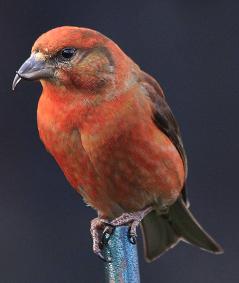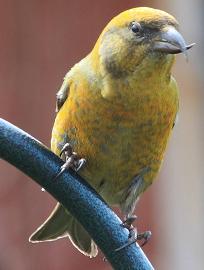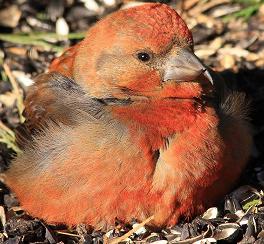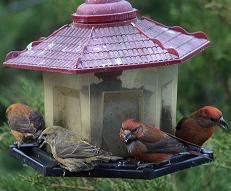 Red Crossbill Red Crossbill
These curious birds may be attracted to backyard
feeders and water.
Identification and Pictures
Red Crossbills (Loxia
curvirostra)
Crossbills are finches
which are about the same size as Sparrows, 5 1/4 to 6
1/2 inches.
They get their name from their
crossed bills, which do not all cross in the same
direction. Their odd bills are useful for removing seeds from
cones. They start at the bottom of a cone, and spiral upward,
opening each scale and removing the seeds with their tongues.
Photos by Keith Lee.
The camera I use is the Canon
EOS 40D.
Visit All-birds store
|
 |
 |
Another
distinctive feature is their long pointed wings. Male Crossbills are
red with dusky wings, and
tail. Young males are more orange. The
females are greenish-yellow with black wings, and the young are
striped.
A similar species the White-winged crossbill has white crossbars on the wings.
Crossbills are often seen hanging from evergreen cones
while they feed on the seeds.
When at feeders these birds can be very curious and may come quite close to people.
|
 There
are 9 species of Crossbills. They do not cross-breed and
they specialize in eating different seeds. The bills are
different in each species. There
are 9 species of Crossbills. They do not cross-breed and
they specialize in eating different seeds. The bills are
different in each species.
When the young birds are learning to extract seeds
from a cone the tips of both top, and bottom bills begin growing.
Because of the pressure from prying, and twisting the upper mandible
will curve down, and the lower mandible will curve up.
Song and Calls
The song sounds like jip-jip jeeaa jeeaa.
Crossbill
sound
Range and Habitat
Red crossbills range across most of North
America, and congregate in areas with pine cone trees.
They are usually in small flocks. They may
move to wooded lowlands in winter, but they do not migrate
like many song birds do.
Crossbills like conifer forests where they can be seen using their bills to grab cones and branches as they climb through the branches.
Trees they like to feed in are
Lodgepole pine, Ponderosa pine, Sitka, and Western hemlock, each species
prefers a certain
type.
Breeding and Nesting
Pairs form within flocks and are monogomous. They can breed
at almost any time of year as long as there is sufficient food
around.
The female builds a cup shaped nest of loose grass,
twigs, moss, and lichen lined with feathers, and fine grass. The nest will
be in pine trees, and the distance from the ground varies. She
will incubate 3 to 5 pale blue spotted eggs for 12 to 15 days.
and lichen lined with feathers, and fine grass. The nest will
be in pine trees, and the distance from the ground varies. She
will incubate 3 to 5 pale blue spotted eggs for 12 to 15 days.
The male will bring food to the female while she is
incubating and to the young for a few days after they hatch.
After about 5 days both parents will feed the young. The young birds
will leave the nest in roughly 20 days, but the parents feed them
for about a month while they learn to feed themselves.
Food and Feeding
Crossbills eat mostly conifer seeds; however they
also eat insects, berries, and other seeds. They will come to
bird feeders for seeds.
Photo by Keith Lee. The
camera I use is the Canon
EOS 40D. Visit All-birds store
For more on food
and feeding click here.
For more on feeders click here.
To learn about other favorite
birds click here.

|
